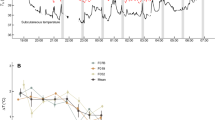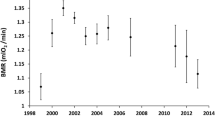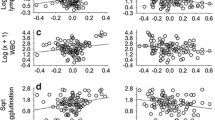Abstract
Life history theory suggests that species experiencing high extrinsic mortality rates allocate more resources toward reproduction relative to self-maintenance and reach maturity earlier (‘fast pace of life’) than those having greater life expectancy and reproducing at a lower rate (‘slow pace of life’). Among birds, many studies have shown that tropical species have a slower pace of life than temperate-breeding species. The pace of life has been hypothesized to affect metabolism and, as predicted, tropical birds have lower basal metabolic rates (BMR) than temperate-breeding birds. However, many temperate-breeding Australian passerines belong to lineages that evolved in Australia and share ‘slow’ life-history traits that are typical of tropical birds. We obtained BMR from 30 of these ‘old-endemics’ and ten sympatric species of more recently arrived passerine lineages (derived from Afro-Asian origins or introduced by Europeans) with ‘faster’ life histories. The BMR of ‘slow’ temperate-breeding old-endemics was indistinguishable from that of new-arrivals and was not lower than the BMR of ‘fast’ temperate-breeding non-Australian passerines. Old-endemics had substantially smaller clutches and longer maximal life spans in the wild than new arrivals, but neither clutch size nor maximum life span was correlated with BMR. Our results suggest that low BMR in tropical birds is not functionally linked to their ‘slow pace of life’ and instead may be a consequence of differences in annual thermal conditions experienced by tropical versus temperate species.


Similar content being viewed by others
References
Ambrose SJ, Bradshaw SD, Withers PC, Murphy DP (1996) Water and energy balance of captive and free-ranging Spinifexbirds (Eremiornis carteri) North (Aves: Sylviidae) on Barrow Island, Western Australia. Aust J Zool 44:107–117
Astheimer LB, Buttemer WA (2002) Changes in latitude, changes in attitude: a perspective on ecophysiological studies of Australian birds. Emu 102:19–27
Blomberg SP, Garland T, Ives AR (2003) Testing for phylogenetic signal in comparative data: behavioral traits are more labile. Evolution 57:717–745
Buttemer WA, Astheimer LB (2000) Testosterone does not affect basal metabolic rate or blood parasite load in captive male White-plumed honeyeaters Lichenostomus penicillatus. J Avian Biol 31:479–488
Cardillo M (2002) The life-history traits of latitudinal diversity gradients: how do species traits vary from the poles to the equator? J Anim Ecol 71:79–87
Chappell MA, Bech C, Buttemer WA (1999) The relationship of central and peripheral organ masses to aerobic performance variation in house sparrows. J Exp Biol 202:2269–2279
Collins BG, Cary G, Payne S (1980) Metabolism, thermoregulation and evaporative water loss in two species of Australian nectar-feeding birds (family Meliphagidae). Comp Biochem Physiol 67A:629–635
Daan S, Masman D, Groenewold A (1990) Avian basal metabolic rates: their association with body composition and energy expenditure in nature. Am J Physiol 259:R333–R340
Felsenstein J (1985) Phylogenies and the comparative method. Am Nat 125:1–15
Geffen E, Yom-Tov Y (2000) Old-endemics and new invaders: alternative strategies of passerines for living in the Australian environment. Behav Ecol Sociobiol 47:250–257
Grafen A (1989) The phylogenetic regression. Phil Trans R Soc Lond Seri B Biol Sci 326:119–157
Hackett SJ, Kimball RT, Reddy S, Bowie RCK, Braun EL, Braun MJ, Chojnowski JL, Cox WA, Han K, Harshman J et al (2008) Phylogenomic study of birds reveals their evolutionary history. Science 320:1763–1768
Higgins PJ, Peter JM (eds) (2002) Handbook of Australian, New Zealand and Antarctic Birds, vol 6. Oxford University Press, Melbourne
Higgins PJ, Peter JM, Steele WK (eds) (2001) Handbook of Australian, New Zealand and Antarctic Birds, vol 5. Oxford University Press, Melbourne
Higgins PJ, Peter JM, Cowling S (eds) (2006) Handbook of Australian, New Zealand and Antarctic Birds, vol 7. Oxford University Press, Melbourne
Hulbert AJ, Else PE (2004) Basal metabolic rate: history, composition, regulation, and usefulness. Physiol Biochem Zool 77:869–876
Jetz W, Freckleton RP, McKechnie AE (2008) Environment, migratory tendency, phylogeny and basal metabolic rate in birds. PLoS One 3(9):e3261
Jetz W, Thomas GH, Joy JB, Hartmann K, Mooers AO (2012) The global diversity of birds in space and time. Nature 491:444–448
Keast A (1981a) Distributional patterns, regional biotas, and adaptations in the Australian biota: a synthesis. In: Keast A (ed) Ecological biogeography of Australia. W. Junk, Hague, pp 1891–1997
Keast A (1981b) Origin and relationship of the Australian biota. In: Keast A (ed) Ecological Biogeography of Australia. W. Junk, The Hague, pp 2001–2050
Lee KA (2006) Linking immune defenses and life history at the levels of the individual and the species. Integr Compar Biol 46:1000–1015
Lill A, Box J, Baldwin J (2006) Do metabolism and contour plumage insulation vary in response to seasonal energy bottlenecks in superb fairy-wrens? Aust J Zool 54:23–30
Londoño GA, Chappell MA, Castenada M, Jankowski JE, Robinson SK (2015) Basal metabolism in tropical birds: latitude, altitude, and the ‘pace of life’. Funct Ecol 29:338–346
Maddocks TA, Geiser F (1997) Energetics, thermoregulation and nocturnal hypothermia in Australian silvereyes. Condor 99:104–112
Magrath RD, Leedman AW, Gardner JL, Giannasca A, Nathan AC, Yezerinac SM, Nicholls JA (2000) Life in the slow lane: reproductive life history of the White-browed Scrubwren, an Australian endemic. Auk 117:479–489
Martin TE (1996) Life history evolution in tropical and south temperate birds: what do we really know? J Avian Biol 27:263–272
Martins EP, Hansen TF (1997) Phylogenies and the comparative method: a general approach to incorporating phylogenetic information into the analysis of interspecific data. Am Nat 149:646–667
McKechnie AE, Swanson DL (2010) Sources and significance of variation in basal, summit and maximal metabolic rates in birds. Curr Zool 56:741–758
McKechnie AE, Wolf BO (2004) The allometry of avian basal metabolic rate: good predictions need good data. Physiol Biochem Zool 77:502–521
McNab BK (2015) Behavioral and ecological factors account for variation in the mass-independent energy expenditures of endotherms. J Comp Physiol B 185:1–13
Moreau RE (1944) Clutch size: a comparative study, with special reference to African birds. Ibis 86:286–342
Pagel M (1999) Inferring the historical patterns of biological evolution. Nature 401:877–884
Paradis E, Claude J, Strimmer K (2004) APE: analyses of phylogenetics and evolution in R language. Bioinformatics 20:289–290
Pearl R (1928) The rate of living: being an account of some experimental studies on the biology of life duration. A. A. Knopf, New York
Pinheiro J, Bates D, DebRoy S, Sarkar D, The R Development Core Team (2013) nlme: linear and nonlinear mixed effects models. R package version 3:1–113
Previtali MA, Ostfield RS, Keesing F, Jolles AE, Hanselmann R, Martin LB (2012) Relationship between pace of life and immune responses in wild rodents. Oikos 121:1483–1492
R Core Team (2013) R: a language and environment for statistical computing. R Foundation for Statistical Computing, Vienna, Austria. http://www.R-project.org
Revell LJ (2010) Phylogenetic signal and linear regression on species data. Methods Ecol Evol 1:319–329
Revell LJ (2012) phytools: an R package for phylogenetic comparative biology (and other things). Methods Ecol Evol 3:217–223
Ricklefs RE, Wikelski M (2002) The physiology/life history nexus. Trends Ecol Evol 17:462–468
Ritz C, Spiess AN (2008) qpcR: an R package for sigmoidal model selection in quantitative real-time polymerase chain reaction analysis. Bioinformatics 24:1549–1551
Rowley I, Russell E (1991) Demography of passerines in the temperate southern hemisphere. In: Perrins CM, Leberton JD, Hirons M (eds) bird population studies. Oxford University Press, Oxford, pp 22–44
Russell EM (2000) Avian life histories: is expanded parental care the southern secret? Emu 100:377–399
Russell EM, Yom-Tov Y, Geffen E (2004) Extended parental care and delayed dispersal: northern, tropical, and southern passerines compared. Behav Ecol 15:831–838
Skutch AF (1985) Clutch size, nesting success, and predation on nests of neotropical birds, reviewed. In: Buckley PA, Foster MS, Morton ES, Ridgley RS, Buckley FG (eds) Neotropical Ornithology, AOU Ornithological Monographs No. 36. AOU, Washington DC, pp 575–594
Stearns SC (2000) Life history evolution: successes, limitations, and prospects. Naturwissenschaften 87:476–486
Vezina F, Jalvingh KM, Dekinga A, Piersma T (2006) Acclimation to different thermal conditions in a northerly wintering shorebird is driven by body mass-related changes in organ size. J Exp Biol 209:3141–3154
Vitali SD, Withers PC, Richardson KC (1999) Standard metabolic rates of three nectarivorous meliphagid passerine birds. Aust J Zool 47:385–391
Weathers WW, Paton DC, Seymour RS (1996) Field metabolic rate and water flux of nectarivorous birds. Aust J Zool 44:445–460
White CR, Seymour RS (2004) Does basal metabolic rate contain a useful signal? Mammalian BMR allometry and correlations with a selection of physiological, ecological and life-history variables. Physiol Biochem Zool 77:929–941
White CR, Blackburn TM, Martin GR, Butler PJ (2007) Basal metabolic rate of birds is associated with habitat temperature and precipitation and not primary productivity. Proc R Soc Biol Sci 274:287–293
Wiersma P, Chappell MA, Williams JB (2007a) Cold- and exercise induced peak metabolic rates in tropical birds. Proc Natl Acad Sci USA 104:20866–20871
Wiersma P, Muñoz-Garcia A, Williams JB (2007b) Tropical birds have a slow pace of life. Proc Natl Acad Sci USA 104:9340–9345
Wiersma P, Nowak B, Williams JB (2012) Small organ size contributes to the slow pace of life in tropical birds. J Exp Biol 215:1662–1669
Wikelski M, Spinney L, Schelsky W, Scheuerlein A, Gwinner E (2003) Slow pace of life in tropical sedentary birds: a common-garden experiment on four stonechat populations from different latitudes. Proc R Soc B Biol Sci 270:2383–2388
Woinarski JCZ (1985) Breeding biology and life history of small insectivorous birds in Australian forests: response to a stable environment? Proc Ecol Soc Austr 14:159–168
Yom-Tov Y (1987) The reproductive rates of Australian passerines. Austr Wildl Res 14:319–330
Acknowledgments
All procedures used in these studies were approved by the University of Wollongong Animal Ethics Committee in accordance with the National Health and Medical Research Council Code of Practice for the Care and Use of Animals for Scientific Purposes. The study was supported by funds from the Australian Research Council (Grant Nos. A19600561 and DP0453021) and the Australian Flora and Fauna Research Centre (to WAB and LBA), U.C. Riverside Academic Senate funds (to MAC), National Science Foundation grant DEB-1120682 (to S. K. Robinson and MAC) and the Norwegian University of Science and Technology (to CB).
Author information
Authors and Affiliations
Corresponding author
Additional information
Communicated by I.D. Hume.
Electronic supplementary material
Below is the link to the electronic supplementary material.
Rights and permissions
About this article
Cite this article
Bech, C., Chappell, M.A., Astheimer, L.B. et al. A ‘slow pace of life’ in Australian old-endemic passerine birds is not accompanied by low basal metabolic rates. J Comp Physiol B 186, 503–512 (2016). https://doi.org/10.1007/s00360-016-0964-6
Received:
Revised:
Accepted:
Published:
Issue Date:
DOI: https://doi.org/10.1007/s00360-016-0964-6




